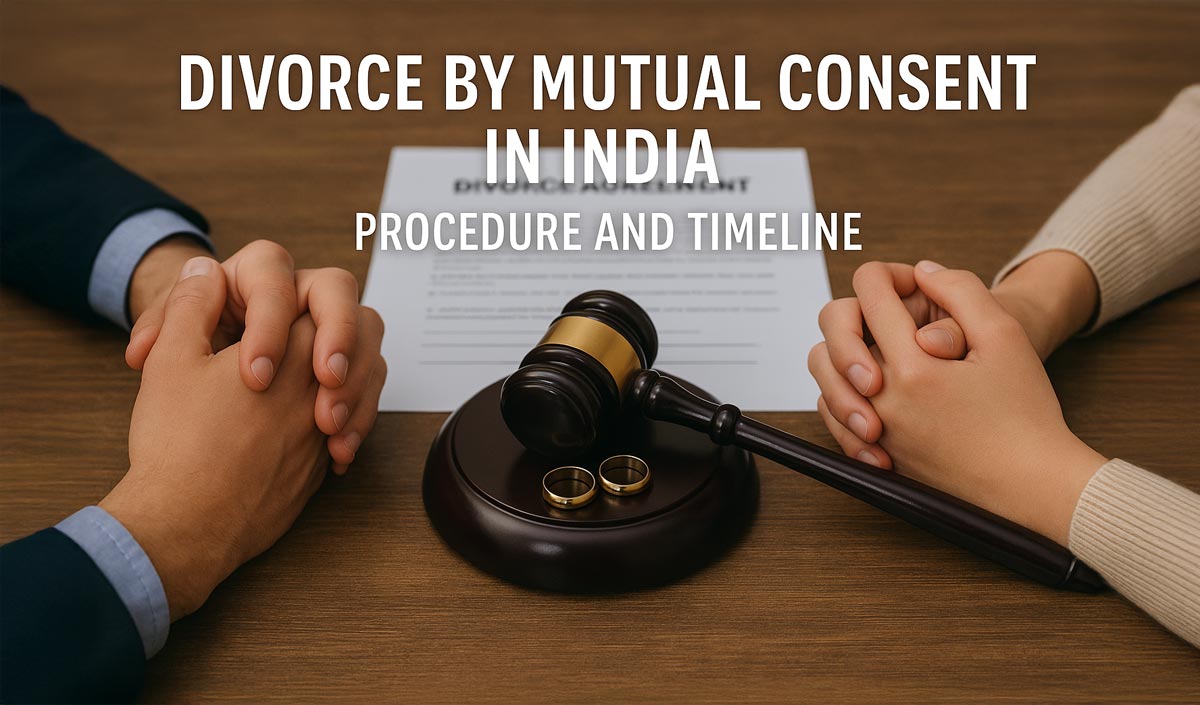Marriage is a big step, but sometimes husbands and wives find that staying together just doesn’t work. If both agree to end things peacefully, a mutual consent divorce is one of the easiest, quickest, and least stressful ways to move forward.
Here’s a step-by-step guide, written in simple language, so you can understand exactly how mutual consent divorce works under Indian law
Step 1: Are You Eligible?
Before you can apply, check these points:
- You and your spouse have been living separately for at least 1 year.
- Both of you must genuinely want the divorce.
- You’ve already agreed on important things:
- Who gets what property/assets
- Custody and care of children
- Alimony or maintenance (if any)
If you disagree on any of these, you’ll need to settle those issues first or else the divorce may become contested, which takes much longer.
Step 2: Prepare Your Divorce Petition
This is just a written request to the Family Court, asking to end your marriage. You and your spouse must sign it together.
What to include:
- Date and place of marriage
- Names, ages, and addresses
- How long have you been living separately
- What you’ve agreed about money, property, and child custody
- Statement that you both want the marriage to end
It’s smart to have a lawyer draft or check your petition. If you can’t afford one, you can write it yourself; the court just wants clear facts and genuine consent.
Step 3: File Your Petition
Submit your signed petition at the Family Court in the city or town:
- Where did you last live together
- Where does either of you live now
- Or where you got married
Attach these documents:
- Marriage certificate.
- Address proof of both spouses.
- Passport-size photographs.
- Simple affidavit declaring separation (just a written, signed statement)
- Your settlement agreement about children, money or property
If you have proof of living apart (like rental agreements or letters from friends), you can attach those, but the court mainly relies on your statements.
Step 4: First Court Appearance (“First Motion”)
You’ll both need to appear before a judge. The judge checks:
- Are both people willing and sure about the divorce?
- Is anyone being forced or pressured?
If the judge is satisfied, they’ll pass a “First Motion” order. At this point, there’s a 6-month cooling-off period—a chance to rethink and make sure it’s what you both want.
(Good news: If you’ve already settled everything and waiting would serve no purpose, the court can reduce or even waive this 6-month wait, depending on your case and recent Supreme Court guidance.)
Step 5: Second Court Appearance (After Cooling-Off Period)
After six months (or sooner, if waived), you both must return to court and confirm you still want the divorce.
- If you both agree, the judge will record your statements and grant the final divorce order (called “decree”).
- Once the decree is passed, your marriage is legally ended and you’re both free to move on with your lives.
How Long Does It Take?
Here’s a quick summary of the timeline:
- Filing petition to first court date: 1–2 weeks
- Cooling-off period: 6 months (sometimes less if waived)
- Final court order after second motion: 1–2 months
Total usually comes to 7–9 months, but can be as fast as 2–3 months if you qualify for a waiver.
Required Documents
- Marriage certificate
- Proof of addresses (Aadhaar, passport, driving license, etc.)
- Recent photos of both parties
- Affidavit about living apart
- Settlement agreement (custody, alimony, property)
Advantages of Mutual Consent Divorce
- Less time-consuming compared to contested divorce.
- Less emotional stress.
- Both parties control the settlement terms.
- Lower legal costs.
Who Can Use Mutual Consent Divorce?
- Hindus under the Hindu Marriage Act, 1955
- Christians under the Indian Divorce Act
- Couples married under Special Marriage Act
- Parsis under the Parsi Marriage and Divorce Act
(The basic idea is the same, but waiting/separation periods might differ slightly for each law. Check with your lawyer if unsure.)
Important Tips
- You must be truly separated, not just fighting or emotionally distant.
- Courts will reject your request if they believe anyone is being forced.
- Even after filing, you have time to reconsider. If either person changes their mind, the divorce won’t go through.
Divorce is a tough and emotional journey. But with mutual consent, it can be much smoother for you, your spouse, and your loved ones. If you and your partner are ready to end things respectfully, this process helps you do so, with dignity and control.
Need help with your name change process?
I’m Advocate Joginder Poswal, helping individuals and businesses across India with legal documentation and advice. I handle cases in Palwal, Gurgaon, and online pan-India.
WhatsApp +91-9911202099 or visit Decipher Consultancy to get started.


One thought on “Divorce by Mutual Consent in India: Procedure and Timeline”
This is a very clear and helpful guide to filing for a mutual-consent divorce in India. The author breaks down the eligibility criteria, documentation, and step-by-step petition process in simple language, making it accessible even for people unfamiliar with legal jargon. He also explains how the usual six-month cooling-off period works, and importantly, how courts may waive it in cases where reconciliation isn’t possible — reflecting recent judicial trends.
Overall, the article does a great job of making a complex legal procedure feel manageable. It’s especially useful for couples who want to end their marriage amicably and want to understand how to do it legally, efficiently, and with dignity.